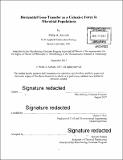Horizontal gene transfer as a cohesive force in microbial populations
Author(s)
Arevalo, Philip A.(Philip Alexander)
Download1019875135-MIT.pdf (10.88Mb)
Other Contributors
Massachusetts Institute of Technology. Department of Biology.
Advisor
Martin F. Polz.
Terms of use
Metadata
Show full item recordAbstract
Populations are the central unit of evolution and ecology. In the context of evolution, populations are commonly defined as groups of organisms with a shared gene pool in which adaptive genes can spread freely through natural selection. Ecology takes a less abstract view of populations and conceives of them as members of a single species that occupy the same geographical area. Among sexual eukaryotes, gene pools are easily defined in terms of reproductive isolation and the geographical scales relevant for populations are well-matched to everyday human experience. Microbiologists, however, have faced a great challenge in applying these concepts to the microbial realm. Can closed gene pools form in the face of apparently rampant horizontal gene transfer? What exactly is a microbial species? And does the famous maxim that '"everything is everywhere" mean that the entire globe is to E. coli what Galapagos is to a finch? In this thesis, I hope to move closer to an answer to these large scale questions by asking two smaller ones. First, can ecologically cohesive microbial populations be identified using genomic information alone? Second, once such populations are identified, what are the relevant factors driving population-Ưlevel differentiation? Horizontal gene transfer plays a central role in answering both of these questions, acting both as a force that allows cohesive microbial populations to form and as a means by which new functions and capabilities are introduced into and spread within populations.
Description
Thesis: Ph. D., Massachusetts Institute of Technology, Department of Biology, 2017 Cataloged from PDF version of thesis. Includes bibliographical references.
Date issued
2017Department
Massachusetts Institute of Technology. Department of BiologyPublisher
Massachusetts Institute of Technology
Keywords
Biology.